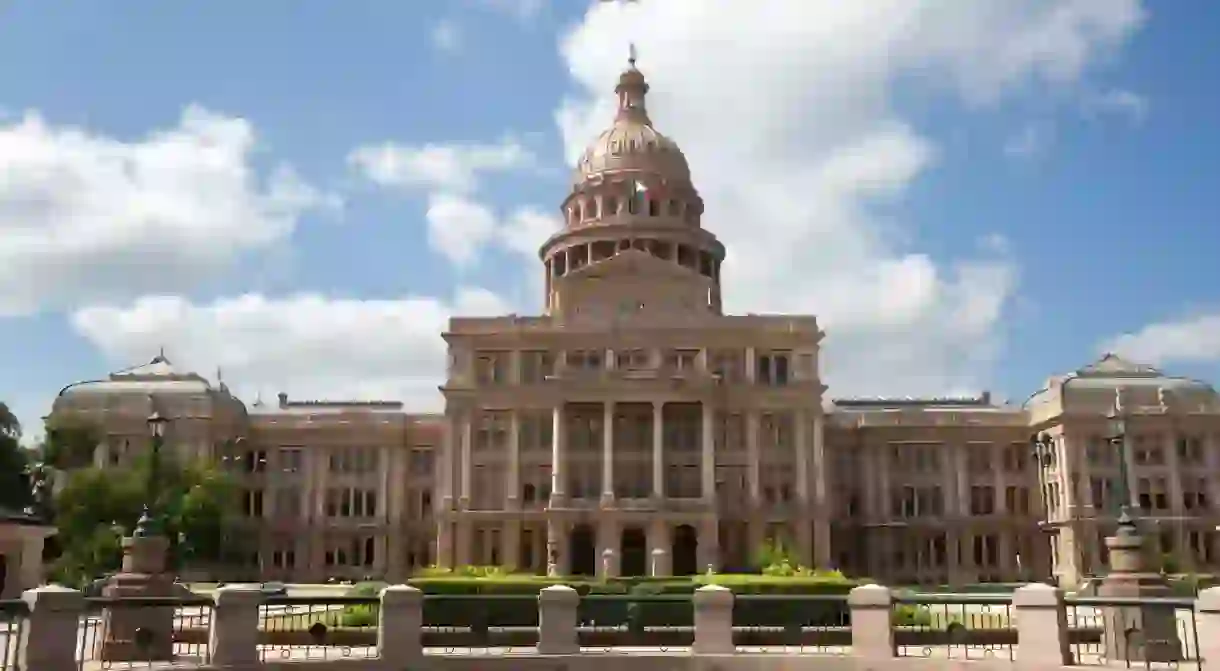A Brief History of the Texas State Capitol Building

In 1882, Austin began construction of the Texas State Capitol because it thought the original capitol building, erected in 1853, too small. The six-year project hinted at the city’s grand hopes for its future.
The Capitol Land Board, which was in charge of overseeing the project, requested design submissions from architects all over the country who were up to the “monumental” challenge. Detroit architect Elijah E Meyer’s proposal was selected, with the condition that he modify the square dome into a circular one; he received West Texas land for his contribution.
The final project covered 22 acres (9 hectares) of land in downtown Austin, and today, many local businesses and high-rises border the building, as can be seen from bustling South Congress Avenue. The famous “sunset” red color of the building comes from the granite used on the exterior.
The circular Capitol Rotunda provides entry points to every other part of the building, and portraits of past Texas governors and presidents of the Republic of Texas line the walls. Don’t forget to look up – the Capitol’s dome is the most mesmerizing element of the building. The very middle features a star with “Texas” spelled out around it, and the symmetrically laid tiles produce impressive echoes. On the very top of the exterior of the dome stands a replica of Meyer’s original Goddess of Liberty statue. Due to deterioration, the original statue was removed by a helicopter in the 1980s and now sits in the nearby Bullock Texas State History Museum.

The Texas House of Representatives, which has 150 members, has met in this room since 1888. The room, reconstructed to look just as it did in 1909, is respectable and polished from its rows of brown leather chairs to the oak paneling and desks to the large brass chandeliers. Every detail of the room was meant to reflect the pride and clout of Texas, including the state emblems imprinted on the floor seats and the star-shaped fixtures with “Texas” spelled out in lights, similar to the design in the dome.
Due to the size of the legislative body, the Texas House of Representatives abandoned traditional vocal voting in 1922 in favor of a mechanical system. The most subtle yet important piece in the room is a flag saved from the Battle of San Jacinto, dating back to 1836, which is so fragile that it hangs only when the legislature is in session; a replica hangs in its place at other times.

The original Supreme Court is also a landmark in itself, and though the court has used off-site courtrooms since 1959, the original ones, located on the third floor, contain their original carpets, furniture and drapes. The court showcases portraits of past justices, including three legendary female justices, appointed when all three male justices were found to be members of a group on trial. It was the first time a woman – or rather three women – held a judgeship in a court in Texas.
The Capitol also contains the governor’s office. This has been true since the enactment of the Texas Constitution in 1876, and the current office sits on the second floor. The former office, restored to its early-1900s appearance, hosts a member of the governor’s staff.

Capitol tours are free and available every day of the week, with hours varying each day. Interested in more Texas history? Check out why you don’t mess with Texas or stop by one of the 10 most unique museums in the state. Also check out these other Austin attractions.













